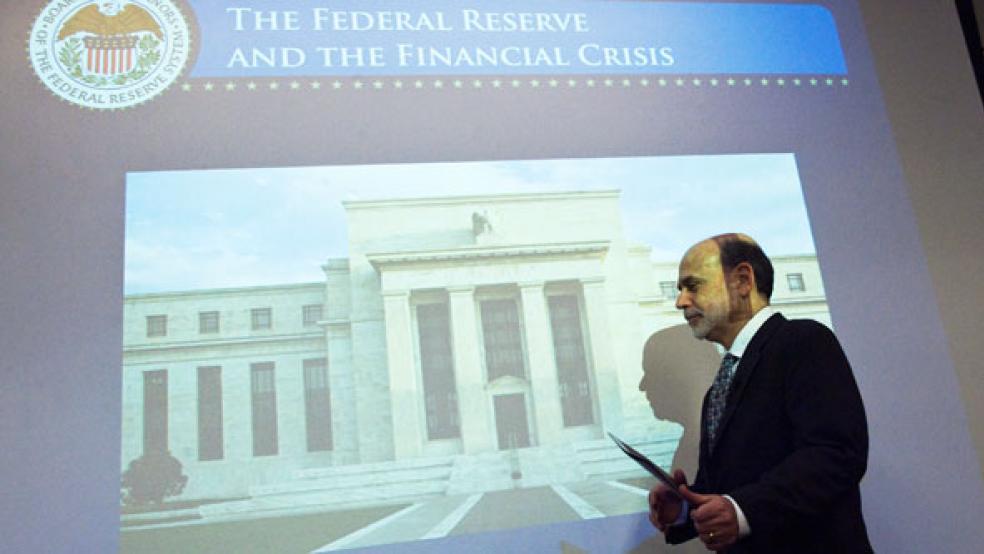Does Fed Chair Ben Bernanke know what he’s doing? We better hope so. Every tweet and cluck from the Open Market Committee has the power to move markets, as we saw again yesterday. Traders dumped stocks after reading the minutes from the central bank’s March 13 meeting; the report hinted at a slightly better job market and doused hopes for another round of quantitative easing.
No wonder all eyes are on the Fed. With fiscal policy frozen, monetary stimulus is the only game in town. Not only is the Fed rolling the dice that near-zero interest rates will promote growth and not light the inflation fuse, the central bank is playing with ever-bigger chips.
The recent release of the Fed funds flow data confirmed just how big those chips are. Treasury securities outstanding at the end of 2011 totaled $10.2 trillion, up from $9.2 trillion a year earlier, a rise of a little more than one trillion dollars that helped finance our deficit. Who picked up all those low-interest securities? Foreigners bought a mere $287 billion, while the Fed picked up most of the slack, buying $642 billion as part of its quantitative easing program.
The household sector was a net seller of Treasuries, as were state and local governments and commercial banks. The only other buyers of size were private pension funds ($81 billion), money market mutual funds ($108 billion ), which presumably scurried to reduce exposure to the EU crisis and (surprisingly) securities firms ($93 billion.)
While upset that our country is racking up trillion-dollar deficits year after year, Americans may be especially alarmed that last year those excesses were not financed by countries like China and Saudi Arabia, as most had thought, but rather by our very own Federal Reserve. It’s a program Bernie Madoff would be proud of.
While the Fed’s easy money policies have been helpful in restoring liquidity and providing some boost to growth, the unprecedented expansion of the Fed’s balance sheet carries a big price tag. Lawrence Goodman, President of the Center for Financial Stability, said in a recent phone conversation, “The Fed’s purchases of Treasury obligations create distortions. Their action pushes interest rates down, penalizing savers and favoring debtors.”
Among other outcomes, Goodman says the Fed’s quantitative easing has increased the volatility of commodities and securities markets and encouraged savers to reach for riskier investments that offer higher yield. This, of course, directly contravenes the Obama administration’s repeated assertions that it would dampen the high-roller nature of financial markets.
The Fed cannot continue to be the buyer of first resort. In a recent presentation in Washington, Goodman argued, “the refunding of U.S. Treasury debt presents an equal challenge to the oft-discussed budget deficits,” raising concerns about a possible disruption to credit markets, and to U.S. growth.
In Goodman’s view, it is “the repayment of principal [that] often triggers a crisis rather than simply the size of the debt or deficit.” He points to the huge spike in U.S. debt maturities due in the coming year, which exceeds 18 percent of GDP – an unprecedented amount of over $2.5 trillion. By comparison, between 1973 and 2007 maturing debt averaged a little under 10 percent. As Fed Chair Ben Bernanke speaks on the value of near-zero interest rates, he must cross his fingers behind his back knowing that it wouldn’t take much – an unexpected blip in inflation, another rumored debt downgrade, a prolonged battle over tax policy – to set interest rates soaring. There is a limit to how much control the Fed can exert, and surely we are fast approaching that point.
We’ve seen this script before. In May 1994 the Fed began to gradually move rates higher, but the marketplace jumped ahead, sending the ten-year to 7.7 percent at year-end from 5.8 percent, clobbering the bond market.
To date, the Fed has shown no inclination to reverse course. The recent announcement from the Fed Open Market Committee suggested that the current environment is “likely to warrant exceptionally low levels for the federal funds rate at least through late 2014.” The brief also reminded us that the Fed has a dual mandate, requiring it to “foster maximum employment and price stability.”
The Fed’s dual (and sometimes contradictory) mandate is visibly at issue today. Bernanke recently spoke at length on “Recent Developments in the Labor Market,” expressing uncertainty about 1) why employment was rising faster than GDP, 2) whether such gains would continue 3) whether perhaps GDP growth has been understated of late 4) whether job losses have been cyclical or structural, 5) whether recent declines in unemployment overstate the improvement in the jobs market 6) whether the gains in 2011 were simply a reversal of outsized-losses in 2009, and 7) what the heck’s coming next.
That speech returns us to our question, does Mr. Bernanke know what he’s doing? Unwittingly, Mr. Bernanke gave us a very good primer in why the Fed should perhaps not be in the position of trying to “control” the economy, and why its guidance in the past has sometimes proved disastrous.






